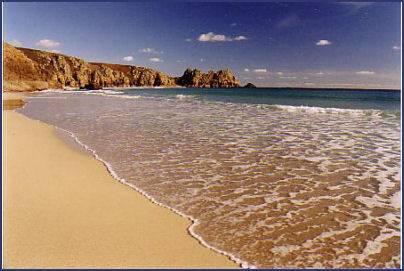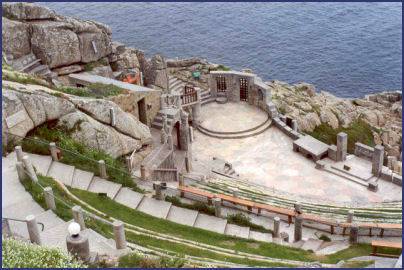Porthcurno
OS grid ref:- SW3822
 The village of Porthcurno lies around 3 miles (5 km)
from Land's End. The name derives from the Cornish Porth Kernow, meaning Port of Cornwall.
The village of Porthcurno lies around 3 miles (5 km)
from Land's End. The name derives from the Cornish Porth Kernow, meaning Port of Cornwall.
Internationally famous as the site of the British termination of early submarine telegraph cables, the first of these cables was layed in 1870, part of an early international link stretching all the way to India. .A cable office was constructed in the lower section of the valley in 1872. The concrete hut, where the cable shore ends were connected to the landlines, is a preserved building and still remains today at the top of the beach.
The Porthcurno Telegraph Museum is a unique, award-winning visitor attraction which is in housed within wartime tunnels, is set in its own grounds in the Porthcurno Valley. The museum chronicles the history of the village as a centre of technology from Victorian times to World War II and relates the story of the birth of modern communications systems. Visitors can view various pieces of working equipment and also hear about the secret communications which were sent from Porthcurno during World War I. Regular demonstrations reveal how the instruments worked, and visitors can enjoy the hands-on activities.
The beach at Porthcurno is one of the best in Cornwall, with golden sand set in a cove beneath towering granite cliffs. A car park is situated around 200 yards above, which has a cafe and nearby restaurant which is open during the season. The car park has toilet facilities. The eastern end of the beach is flanked by the Treryn Dinas headland, on which the Logan Rock, a huge stone weighing around 70 tons, may be seen
 The village
church of St. Levan dates to the thirteenth century, the church contains St Levan's stone, which according to legend, was used by the saint as a seat.
St. Levan, a Celtic saint, once lived in Porthcurno. The village also contains is a pre-Christian holy well. As is the case with many holy wells in Cornwall, its water is reputed to have healing powers and is still used in the
Church for baptisms. It can be reached by a flight of granite steps.
The village
church of St. Levan dates to the thirteenth century, the church contains St Levan's stone, which according to legend, was used by the saint as a seat.
St. Levan, a Celtic saint, once lived in Porthcurno. The village also contains is a pre-Christian holy well. As is the case with many holy wells in Cornwall, its water is reputed to have healing powers and is still used in the
Church for baptisms. It can be reached by a flight of granite steps.
There are a number of attractive cliff top walks along the coastal path in the area, just beyond the headland lies beautiful Penberth Cove, an unspoilt fishing cove which is owned by the National Trust.
Set high on the cliffs above Porthcurno is the famous Minack Theatre, an open-air theatre, built above a gully with a rocky outcrop which juts into the sea. The Minack, which in Cornish means a stony or rocky place, was started by Rowena Cade, a Porthcurno resident. A local dramatic group performed Shakespeare's 'A Midsummer Night's Dream' in a nearby field and Rowena Cade offered her garden, which overlooked Porthcurno Bay, as the venue for their next intended production 'The Tempest'. A terrace and seating was installed in the garden for the play, and in 1932, the Tempest was performed there, with Porthcurno Bay forming an aptly dramatic background. The theatre, over the years, was improved upon by Rowena Cade with the help of others.
The Minack Theatre has developed over the years since its inception and is currently offers a varied programme from June to September, when 17 plays are performed annually, it is open to visitors throughout the rest of the year.
Image 2 copyright Neil Kennedy
A walk from Porthcurno to Land's End
Distance 6.5 miles
*Commencing from the main car park Porthcurno village, walk down to the beach after which follow the waymarked South West Coastal Path which skirts around the inland side of the world famous Minack Theatre and takes you into the theatre's car park.
* Cross the car park and exit at its western end to rejoin the coastal footpath, follow the path slong the cliff tops before descending to cross the back of Porth Chapel beach.
*Continue along the coastal path to the hamlet of Porthgwarra. Remain on the path nearest to the sea, care should be exercised in wet or windy weather along the cliffs.
*Continuing west on the coastal path, passing the lovely bay Nanjizal, shortly after passing the buildings on Land's End, the most westerly point of the British mainland, come into view.
*Retrace your steps from Land's End to return to Porthcurno.